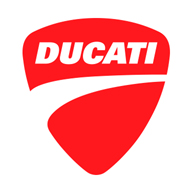Ducati
motorcycle manufacturer (1926)
Ducati is an Italian motorcycle manufacturer. It has its headquarters in Bologna, in the Borgo Panigale district.
Ducati Motor Holding S.p.A., the full name, is controlled by Lamborghini Automobili S.P.A., which in turn refers to Audi, which in turn is included in the Volkswagen Group.
In 1924 Adriano Cavalieri Ducati, a physics student, became famous for making a radio connection between Italy and America with a short-wave device he had designed. On the enthusiasm of that success, the Ducati family founded the "Società Scientifica Radio Brevetti Ducati" on 4 July 1926, with the aim of studying radio and telephone transmission technologies.
Years later, from that "modest" radioelectric material industry, Ducati was born, one of the most prestigious motorcycle manufacturers in the world.
After the death of the founder, his sons, Bruno, Adriano and Marcello, continued the family business, continuing to work in the transmission sector until the Second World War, when the factory was partially destroyed.
In 1946, once the war was over, the Ducati brothers did not abandon the company and at the request of IRI the motorcycle department was born, as a branch of the company, with the aim of producing the Cucciolo, a 48 cc single-cylinder engine with gearbox two speeds to be applied to a normal bicycle.
The company, partially rebuilt, began production of the Cucciolo in March 1946, the first motorcycle product made in the new headquarters in Borgo Panigale.
In 1948, due to the damage suffered during the war, the Ducati brothers were no longer able to manage the company and had to sell it to "Italian state holdings".
After the success of Cucciolo, Ducati is projected towards the future and begins producing its first complete motorcycle, the Ducati 60, in the Borgo Panigale factory.
In 1954, Fabio Taglioni was hired at "Ducati Meccanica", the designer from Romagna who between 1954 and 1984 developed over a thousand motorcycle and engine projects for Ducati and the technologies still used, such as the desmodromic system, the twin-cylinder engine and the chassis. trellis.
During this period Ducati also produced two scooters, the Cruiser in 1952 and the Brio in 1963.
In the 1960s, Ducati earned its place in motorcycling history by producing the fastest 250cc street bike of the time, the Mach 1.
In the 1970s Ducati produced motorcycles with large-displacement V-twin engines and in 1973 introduced its trademark desmodromic valve design.
Since 1975, Ducati came under state control through EFIM, which in 1978 sold it to VM Motori (still under state control, part of Finmeccanica), which deals with industrial and automotive diesel engines. The difficulties on the market (especially the US), due to the Japanese brands, led the company to remove motorcycles from its priorities.
In 1985, Cagiva acquired Ducati and plans to rename Ducati motorcycles with the "Cagiva" name but retains the "Ducati" name on its motorcycles.
Eleven years later, in 1996, Cagiva accepted the offer of the Texas Pacific Group and sold 51% in the company. In 1998, Texas Pacific Group acquired most of the remaining 49% to become the sole owner of Ducati. In 1999, TPG (Texas Pacific Group) launches a public offering of Ducati shares and renames the company to "Ducati Motor Holding SpA".
In December 2005, Ducati returned to Italian ownership with the sale to Investindustrial Holdings, the investment fund of Carlo and Andrea Bonomi.
In 2012, the acquisition of Ducati Motor Holding SpA by Lamborghini Automobili S.p.A. was announced.











